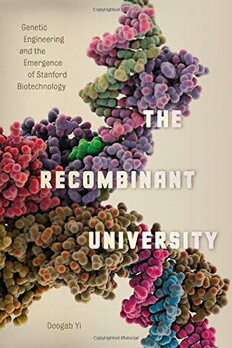
The Recombinant University: Genetic Engineering and the Emergence of Stanford Biotechnology PDF
Preview The Recombinant University: Genetic Engineering and the Emergence of Stanford Biotechnology
The Recombinant University A series in the history of chemistry, broadly construed, edited by Angela N. H. Creager, Ann Johnson, John E. Lesch, Lawrence M. Principe, Alan Rocke, E. C. Spary, and Audra J. Wolfe, in partnership with the Chemical Heritage Foundation. The Recombinant University Genetic Engineering and the Emergence of Stanford Biotechnology doogab yi the university of chicago press chicago and london doogab yi is assistant professor of history and science and technology studies at Seoul National University, where he teaches the history of science as well as science and the law. The University of Chicago Press, Chicago 60637 The University of Chicago Press, Ltd., London © 2015 by The University of Chicago All rights reserved. Published 2015. Printed in the United States of America 24 23 22 21 20 19 18 17 16 15 1 2 3 4 5 isbn- 13: 978-0 - 226- 14383- 5 (cloth) isbn- 13: 978-0 - 226- 21611- 9 (e- book) doi: 10.7208/chicago/9780226216119.001.0001 Library of Congress Cataloging- in- Publication Data Yi, Doogab, 1974– author. The recombinant university : genetic engineering and the emergence of Stanford biotechnology / Doogab Yi. pages cm — (Synthesis) Includes bibliographical references and index. isbn 978- 0- 226- 14383- 5 (cloth : alkaline paper) — isbn 978- 0- 226- 21611- 9 (e- book) 1. Recombinant DNA—Research—California—Stanford—History—20th century. 2. Genetic engineering—Research—California—Stanford—History—20th century. 3. Biotechnology—Research—California—Stanford—History—20th century. 4. Stanford University—History—20th century. I. Title. II. Series: Synthesis (University of Chicago. Press) qh442.y54 2015 572.8'77—dc23 2014031905 ♾ This paper meets the requirements of ansi/niso z39.48- 1992 (Permanence of Paper). for jawon Contents Acknowledgments ix Introduction 1 chapter 1. Communal Form of DNA Research 18 chapter 2. “Mass Migration” and Technologies of Gene Manipulation 53 chapter 3. System of Exchange in Recombinant DNA Research 83 chapter 4. Moral and Capitalistic Economies of Gene Cloning 113 chapter 5. Who Owns What? Private Ownership and Public Interest 138 chapter 6. Reenvisioning the Biomedical Enterprise in the Age of Commercial Biotechnology 172 Conclusion 213 List of Abbreviations 221 Notes 223 Works Cited 283 Index 309 Acknowledgments Ih ave incurred many debts in the course of this book project, and I am very happy to have the chance finally to acknowledge some of the many people to whom I am indebted. First, I would like to thank An- gela Creager, Michael Gordin, Graham Burnett, and Bruno Strasser, for their scholarly guidance and help at the initial stage of this book project. Their scholarly erudition, sharp historical analysis, and encouragement are greatly appreciated. While book writing can be a solitary activity, I have been very fortunate to be surrounded by wonderful individuals in a supportive environment. I especially learned so much from those at the History of Science Pro- gram at Princeton. Among them, I would like to thank Dan Bouk, John DiMoia, Nathan Ha, Kevin Kruse, Elizabeth Lunbeck, the late Michael Mahoney, Tania Munz, Joe November, Daniel Rodgers, Alistair Sponsel, Jeris Stueland, Helen Tilley, and Matt Wisnioski, for their valuable feed- back and patience. Those at the Office of History, National Institutes of Health (NIH), and National Library of Medicine provided a collegial en- vironment and useful suggestions for revising my manuscript. Among them, I would like to thank Eric Boyle, David Cantor, Brian Casey, Chin Jou, Sharon Ku, Robert Martensen, Todd Olzewski, Sejal Patel, and Laura Stark. A few NIH scientists and former administrators, especially Mel De- pamphilis, the late Norman Latker, and Bernard Talbot, provided their recollections and offered valuable suggestions on my book draft. I owe special thanks to Dr. John E. Niederhuber, then director of the National Cancer Institute, for supporting my Stetten Fellowship from 2008 to 2011. Many historians of science whom I encountered during this project have provided stimulating points of discussions and sources of inspira- tions. I especially thank Elizabeth Berman, Soraya de Chadarevian, Na-
